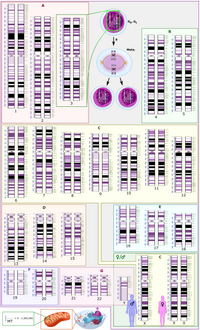
Photo from wikipedia
In order to identify factors involved in transcription of human snRNA genes and 3′ end processing of the transcripts, we have carried out CRISPR affinity purification in situ of regulatory… Click to show full abstract
In order to identify factors involved in transcription of human snRNA genes and 3′ end processing of the transcripts, we have carried out CRISPR affinity purification in situ of regulatory elements (CAPTURE), which is deadCas9-mediated pull-down, of the tandemly repeated U2 snRNA genes in human cells. CAPTURE enriched many factors expected to be associated with these human snRNA genes including RNA polymerase II (pol II), Cyclin-Dependent Kinase 7 (CDK7), Negative Elongation Factor (NELF), Suppressor of Ty 5 (SPT5), Mediator 23 (MED23) and several subunits of the Integrator Complex. Suppressor of Ty 6 (SPT6); Cyclin K, the partner of Cyclin-Dependent Kinase 12 (CDK12) and Cyclin-Dependent Kinase 13 (CDK13); and SWI/SNF chromatin remodelling complex-associated SWI/SNF-related, Matrix-associated, Regulator of Chromatin (SMRC) factors were also enriched. Several polyadenylation factors, including Cleavage and Polyadenylation Specificity Factor 1 (CPSF1), Cleavage Stimulation Factors 1 and 2 (CSTF1,and CSTF2) were enriched by U2 gene CAPTURE. We have already shown by chromatin immunoprecipitation (ChIP) that CSTF2—and Pcf11 and Ssu72, which are also polyadenylation factors—are associated with the human U1 and U2 genes. ChIP-seq and ChIP-qPCR confirm the association of SPT6, Cyclin K, and CDK12 with the U2 genes. In addition, knockdown of SPT6 causes loss of subunit 3 of the Integrator Complex (INTS3) from the U2 genes, indicating a functional role in snRNA gene expression. CAPTURE has therefore expanded the repertoire of transcription and RNA processing factors associated with these genes and helped to identify a functional role for SPT6.
Journal Title: Biomolecules
Year Published: 2022
Link to full text (if available)
Share on Social Media: Sign Up to like & get
recommendations!